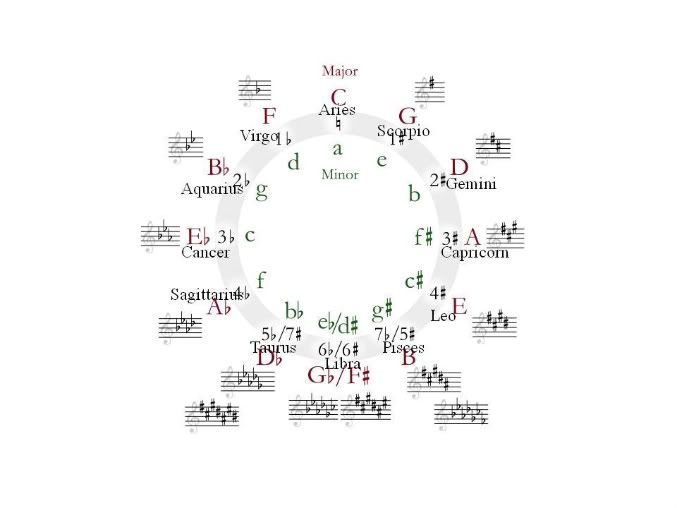O
OrcinusOrca
I often compose music using this basic system of comparison that I devised. It’s simple but it works.
There's twelve notes in the Octave, twelve houses, twelve signs.
Capricorn is at the beginning of the year in terms of the Roman calender, and A is the beginning of the alphabet. However in Western music “C” is always the starting key in most cases because in it's Ionian or Major form it has no sharps or flats which corresponds to Aries which is seen as the 1st sign in Astrology.
So for me the corresponding note/key for each house sign is
C = 1st house = Aries
C#/Db = 2nd house = Taurus
D = 3rd house = Gemini
D#/Eb = 4th house = Cancer
E = 5th house = Leo
F = 6th house = Virgo
F#/Gb = 7th house = Libra
G = 8th house = Scorpio
G#/Ab = 9th house = Sagittarius
A = 10th house = Capricorn
A#/Bb = 11th house = Aquarius
B = 12th house = Pisces
The opposition of each sign corresponds to be the tritone of each note. Eg. Aries to Libra: 1st to 7th: C to F#.
An example of a major chord is: “C,E,G” which corresponds to 1st,5th and 8th houses. Or a grouping of Aries, Leo and Scorpio. Leo is the major third of Aries. Take out the G; the Scorpio: the 8th and add an A: Capricorn, 10th and now we have the relative minor. The A minor “A,C,E” which corresponds to 10th, 1st, 5th…(Capricorn, Aries, Leo.)
Sagittarius still has a strong link to Aries as well though as a major chord starting at G#/Ab (Sagittarius) needs a C (Aries) to be it’s major third.
The major scale of Aries is: Aries (1) (C), Gemini (3)(D), Leo (5)(E), Virgo (6)(F), Scorpio (8)(G), Capricorn (10)(A), Pisces (12)(B).
These are just some basics but the comparison is endless...
There's twelve notes in the Octave, twelve houses, twelve signs.
Capricorn is at the beginning of the year in terms of the Roman calender, and A is the beginning of the alphabet. However in Western music “C” is always the starting key in most cases because in it's Ionian or Major form it has no sharps or flats which corresponds to Aries which is seen as the 1st sign in Astrology.
So for me the corresponding note/key for each house sign is
C = 1st house = Aries
C#/Db = 2nd house = Taurus
D = 3rd house = Gemini
D#/Eb = 4th house = Cancer
E = 5th house = Leo
F = 6th house = Virgo
F#/Gb = 7th house = Libra
G = 8th house = Scorpio
G#/Ab = 9th house = Sagittarius
A = 10th house = Capricorn
A#/Bb = 11th house = Aquarius
B = 12th house = Pisces
The opposition of each sign corresponds to be the tritone of each note. Eg. Aries to Libra: 1st to 7th: C to F#.
An example of a major chord is: “C,E,G” which corresponds to 1st,5th and 8th houses. Or a grouping of Aries, Leo and Scorpio. Leo is the major third of Aries. Take out the G; the Scorpio: the 8th and add an A: Capricorn, 10th and now we have the relative minor. The A minor “A,C,E” which corresponds to 10th, 1st, 5th…(Capricorn, Aries, Leo.)
Sagittarius still has a strong link to Aries as well though as a major chord starting at G#/Ab (Sagittarius) needs a C (Aries) to be it’s major third.
The major scale of Aries is: Aries (1) (C), Gemini (3)(D), Leo (5)(E), Virgo (6)(F), Scorpio (8)(G), Capricorn (10)(A), Pisces (12)(B).
These are just some basics but the comparison is endless...



